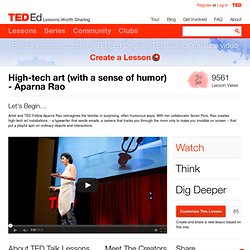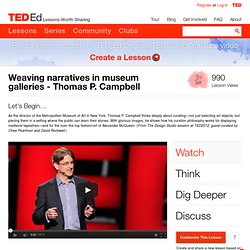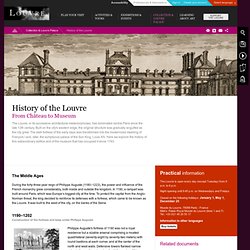

Ursus Wehrli: Tidying up art. Paul Bloom: The origins of pleasure. David Macaulay: An illustrated journey through Rome. Siegfried Woldhek: The search for the true face of Leonardo. Thomas P. Campbell: Weaving narratives in museum galleries. Maurizio Seracini: The secret lives of paintings. Cultural Institute. Gardner's Art through the Ages: A Global History (with ArtStudy Printed Access Card and Timeline) by Fred S. Kleiner, Outlines & Chapter Notes. Images. Mark Harden's Artchive. What the Monuments Men Wrought. Mystery of the Nazi and the portrait of a Welsh lady. 16 January 2014Last updated at 19:02 ET By Stephen Evans BBC News, Berlin A portrait of a 16th Century Welsh noblewoman was discovered in the art collection of leading Nazi Hermann Goering.

What was it doing there? She seems the gentlest of gentlewomen as she stands reflectively. Her skin is pale against the blackness of her dress. She holds a prayer book, indicating devout learning. So how did this grand Welsh lady get to mix with bad Nazi company? The subject of the painting is Catrin of Berain - or Katheryn to her English friends. The story of how the painting went from Wales to Berlin and then back to the National Museum of Wales has been pieced together by experts keen to establish that there are no legitimate counter-claims to its ownership. Looking at Catrin's life story, it's difficult to see why exactly a top Nazi might take an interest in her. Catrin's father was a land-owner, Tudur ap Robert, with a substantial 3,000 acres. Goering was Hitler's deputy Area around Denbigh 1885.
How art can help you analyze - Amy E. Herman. High-tech art (with a sense of humor) - Aparna Rao. As Rao describes her caricature of an upside-down man, she comments, “We wanted to instill in the viewer an instinct to almost go and help or save the subject.”

Aparna Rao and her collaborator Soren Pors are among the artists who are redefining the relationship between the artist, the viewer, and the artwork through interactive installations. Imagine you could create an interactive installation in your school or community. What would you design, and why? For inspiration, explore more interactive art. To get started: TED talk “Golan Levin makes art that looks back at you” Noupe’s “15 Amazing Interactive Installations”
How to find the true face of Leonardo - Siegfried Woldhek. The Dawn of Art. There are about 400 art sites in Europe from the Ice Age time period known as the Upper Paleolithic (dating to between 10,000 and 40,000 years ago).

Chauvet is unusual due to the quality of the art as well as its age (30,000 to 35,000 BP) BP = before present – this far back we don’t usually use BC or AD. Check out the information below, and then answer the questions in the Think section. 1. Currently the oldest known art in Europe comes from a site called El Castillo in Spain - more information about this study can be found here. Distorting Madonna in Medieval art - James Earle. Be sure to visit James Earle's YouTube Channel.

Cimabue also known as Bencivieni di Pepo or in modern Italian, Benvenuto di Giuseppe, was a Florentine painter and creator ofmosaics. How art gives shape to cultural change - Thelma Golden. Black Male was the title of an art exhibition at the Whitney Museum of American Art in1994 in New York.

Harlem Renaissance is a cultural movement that spanned the 1920s and 1930s. At the time, it was known as the "New Negro Movement. " The Studio Museum in Harlem is the nexus for artists of African descent locally, nationally, and internationally and for work that has been inspired and influenced by black culture. It is a site for the dynamic exchange of ideas about art and society.
Muhammed Ali, world heavyweight boxing champion, delivered a 30-minute lecture in 1975 at Harvard University on friendship and the heart. Weaving narratives in museum galleries - Thomas P. Campbell. MetMedia is a great place to check out interactive exhibits, videos and social media from the Metropolitan Museum of Art.

Learn more about specific Met exhibits and collections described in the talk:Alexander McQueen: Savage BeautyThe Islamic Art Department and a video on its recent installationThe history of tapestries and the Met's publication "Tapestry in the Renaissance: Art and Magnificence" What is the role of a museum? Exhibitionist Journal asks What, if Anything, Is a Museum? In this article by exhibit developer Eugene Dillenburg. And Fiona Romeo, head of design and digital media at the National Maritime Museum and Royal Observatory, relates museum curation to stop-motion animation in "Once Upon a Museum. " Da Vinci's Vitruvian Man of math - James Earle. Pico della Mirandola’s Oration on the Dignity of Man Numberphile did a great explanation of “Squaring the Circle” See James Earle's other Lesson.

After Rome was destroyed, people were wary of attachment to physical beauty. As Christianity gained traction, Romans instead began to focus on the metaphysical beauty of virtue, and art began to follow suit. James Earle discusses how Medieval paintings of Madonna were affected by this shift. Dissecting Botticelli’s Adoration of the Magi - James Earle. Sandro Botticelli was an Italian painter and draughtsman.

During his lifetime he was one of the most acclaimed painters in Italy, being summoned to take part in the decoration of the Sistine Chapel in Rome and earning the patronage of the leading families of Florence, including the Medici.The House of Medici was a political dynasty, banking family, and, later, royal house that first began to gather prominence under Cosimo de' Medici in the Republic of Florence during the late 14th century. The family originated in the Mugello region of the Tuscan countryside, gradually rising until they were able to found the Medici Bank.
The bank was the largest in Europe during the 15th century, seeing the Medici gain political power in Florence — though officially they remained simply citizens rather than monarchs.See James Earle's other lesson. After Rome was destroyed, people were wary of attachment to physical beauty. Your Paintings. Antiques Roadshow portrait revealed to be by Van Dyck. Welsh church uncovers stunning medieval wall paintings.
Mrsgibson26's channel. Art History. MetMedia. History of the Louvre. The Middle Ages During the forty-three-year reign of Philippe Auguste (1180–1223), the power and influence of the French monarchy grew considerably, both inside and outside the kingdom.

In 1190, a rampart was built around Paris, which was Europe’s biggest city at the time. To protect the capital from the Anglo-Norman threat, the king decided to reinforce its defenses with a fortress, which came to be known as the Louvre. Art History. Press ctrl and F (or Command and F on a Mac) to perform a keyword search of this page. To keyword search all Best of History Web Sites pages use the search engine located on each page. Art History Web Sites Lesson Plans, Activities, and more The Metropolitan Museum of Art There is much quality material for art students, educators, and enthusiasts at the The Metropolitan Museum of Art web site. Fondation J.-E Berger-World Art Treasures. Home 100,000 Pictures Europe Austria.

Art cyclopedia: The Fine Art Search Engine. Art History PowerPoint Shows. Smarthistory: a multimedia web-book about art and art history. Site Index. Cultural Institute. A Guide to Writing in Art History. VOS Art History. Best of Art History. Heilbrunn Timeline of Art History. Art History and Music Games and Activities.
10 Famous Paintings with Hidden Codes. Mona Lisa: A Real Hidden Code in Her Eyes Intrigue is usually focused on her enigmatic smile. However, when viewed under a microscope, historians in Italy have discovered that by magnifying the eyes of the "Mona Lisa" tiny numbers and letters can be seen. Experts say the barely distinguishable letters and numbers represent something of a real-life Da Vinci Code: in the right eye appear to be the letters LV which could well stand for his name, Leonardo Da Vinci, while in the left eye there are also symbols but they are not as defined.
Of course, it's very difficult to make them out clearly but they appear to be the letters CE, or it could be the letter B. Most Controversial Paintings in Art History. Most Controversial Paintings in Art History Posted by Susan Benford An art history blog post from Famous Paintings Reviewed. What are the most controversial paintings in art history? When Modern Teenagers Interpret Classic Art. The most expensive pieces of art. Watch Great Museums online.
Art History in a Hurry. Watch The Rape of Europa Online. The 5 ? Art History Quiz by Carol Sutton. Www.carolsutton.net The 5 ? Art History Quiz by Carol Sutton This little 5 question Art History Quiz is fun to do and not too difficult. I plan to change the quiz bi monthly and add new questions and answers. Peace Coming Attractions = Next Quiz # 9 8 -- Peace - includes a special 4 page subset on Picasso and his birds What figures or monuments jointly represent spiritual force, symbols of peace, and religion? Art History Quizzes and Art History Trivia. AP Art History Exam Review. Sample Test Questions. 64. These two paintings, both by Sofonisba Anguissola, were created during which century? Fifteenth Sixteenth Seventeenth Eighteenth 65. In Our Time: The Museum of Modern Art. Modern and Contemporary Art. Among the department's highlights are iconic works by members of the School of Paris, such as Balthus, Georges Braque, Henri Matisse, Joan Miró, Amedeo Modigliani, and Pablo Picasso.
The department is also rich in works by the circle of early American modernists around Alfred Stieglitz, including Arthur Dove, Marsden Hartley, Georgia O'Keeffe, and John Marin; large-scale paintings by Abstract Expressionists, such as Willem de Kooning, Jackson Pollock, and Mark Rothko; and modern design, from Josef Hoffmann and members of the Wiener Werkstätte to Art Nouveau jewelry by René Lalique. The Impressionists. History of the Louvre. Essential Vermeer. Bosch: Earthly Delights. Netherlandish Proverbs.
Netherlandish Proverbs (Dutch: Nederlandse Spreekwoorden; also called Flemish Proverbs, The Blue Cloak or The Topsy Turvy World) is a 1559 oil-on-oak-panel painting by the Flemish artist Pieter Bruegel the Elder that depicts a scene in which humans and, to a lesser extent, animals and objects, offer literal illustrations of Dutch language proverbs and idioms.
Running themes in Bruegel's paintings are the absurdity, wickedness and foolishness of humans, and this is no exception. The painting's original title, The Blue Cloak or The Folly of the World, indicates that Bruegel's intent was not just to illustrate proverbs, but rather to catalog human folly. Pieter Bruegel the Elder, The Dutch Proverbs, 1559. 15th Century Flemish Style Portraits Recreated In Airplane Lavatory. 836K views 182 days ago by Justina While on a long-haul flight, when most people would sleep, read a book or chew on complimentary snacks, Nina Katchadourian spends her time locked in the airplane’s lavatory taking selfies in the style of 15th century Flemish paintings. Her series, dubbed “Lavatory Self-Portraits in the Flemish Style,” is part of a bigger piece called “Seat Assignment,” which is based on improvising with materials close at hand while in flight .
[Read more...] Here’s Katchadourian telling the birth story of her project: “While in the lavatory on a domestic flight in March 2010, I spontaneously put a tissue paper toilet cover seat cover over my head and took a picture in the mirror using my cellphone. Secrets of 'The Last Supper'" Titian's Venus of Urbino. Art Home | ARTH Courses | ARTH 200 Assignments | ARTH 213 Assignments. Bayeux Tapestry. Medieval Art and The Cloisters. The American Wing. European Sculpture and Decorative Arts. European Paintings. Greek and Roman Art. What's On View. Greek Art. Aegean Art. Is the Mask a Hoax? Egyptian Art. Reptilian Kings and Rulers. ODYSSEY/NearEast. Ancient Near Eastern Art. Prehistoric Art. The Cave of Chauvet-Pont-d'Arc. Prehistoric Female Artists Stenciled Their Hands. Asian Art. Arts of Africa, Oceania, and the Americas. Islamic Art.